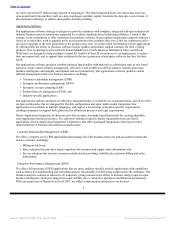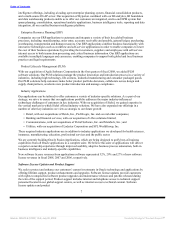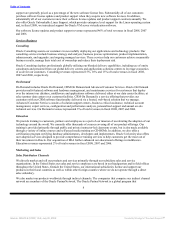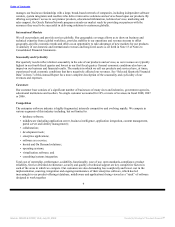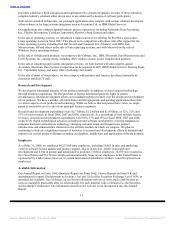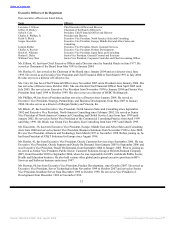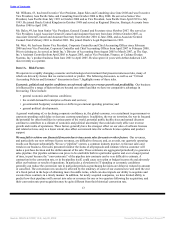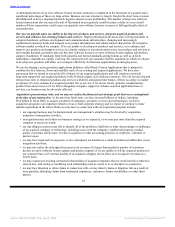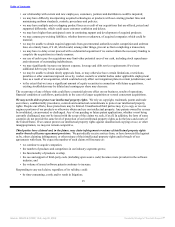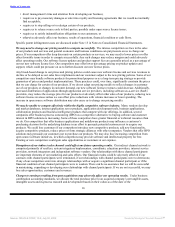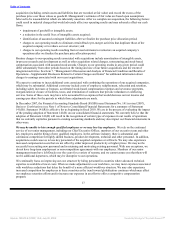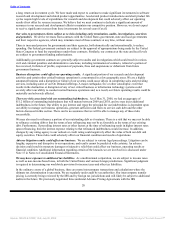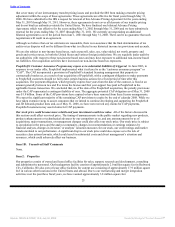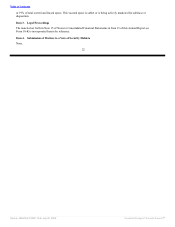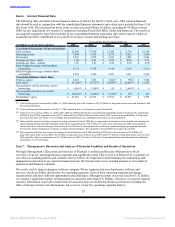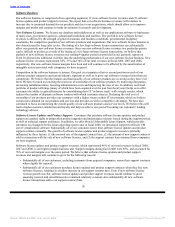Oracle 2007 Annual Report Download - page 21
Download and view the complete annual report
Please find page 21 of the 2007 Oracle annual report below. You can navigate through the pages in the report by either clicking on the pages listed below, or by using the keyword search tool below to find specific information within the annual report.
Table of Contents
• divert management’s time and attention from developing our business;
• require us to pay monetary damages or enter into royalty and licensing agreements that we would not normally
find acceptable;
• require us to stop selling or to redesign certain of our products;
• require us to release source code to third parties, possibly under open source license terms;
• require us to satisfy indemnification obligations to our customers; or
• otherwise adversely affect our business, results of operations, financial condition or cash flows.
Specific patent infringement cases are discussed under Note 15 in Notes to Consolidated Financial Statements.
We may need to change our pricing models to compete successfully. The intense competition we face in the sales
of our products and services and general economic and business conditions can put pressure on us to change our
prices. If our competitors offer deep discounts on certain products or services, we may need to lower prices or offer
other favorable terms in order to compete successfully. Any such changes may reduce margins and could adversely
affect operating results. Our software license updates and product support fees are generally priced as a percentage of
our net new software license fees. Our competitors may offer lower percentage pricing on product updates and
support, which could put pressure on us to further discount our new license prices.
Any broad-based change to our prices and pricing policies could cause new software license and services revenues to
decline or be delayed as our sales force implements and our customers adjust to the new pricing policies. Some of our
competitors may bundle software products for promotional purposes or as a long-term pricing strategy or provide
guarantees of prices and product implementations. These practices could, over time, significantly constrain the prices
that we can charge for certain of our products. If we do not adapt our pricing models to reflect changes in customer
use of our products or changes in customer demand, our new software license revenues could decrease. Additionally,
increased distribution of applications through application service providers, including software-as-a-service (SaaS)
providers, may reduce the average price for our products or adversely affect other sales of our products, reducing new
software license revenues unless we can offset price reductions with volume increases or lower spending. The
increase in open source software distribution may also cause us to change our pricing models.
We may be unable to compete effectively within the highly competitive software industry. Many vendors develop
and market databases, internet application server products, application development tools, business applications,
collaboration products and business intelligence products that compete with our offerings. In addition, several
companies offer business process outsourcing (BPO) as a competitive alternative to buying software and customer
interest in BPO solutions is increasing. Some of these competitors have greater financial or technical resources than
we do. Our competitors that offer business applications and middleware products may influence a customer’s
purchasing decision for the underlying database in an effort to persuade potential customers not to acquire our
products. We could lose customers if our competitors introduce new competitive products, add new functionality,
acquire competitive products, reduce prices or form strategic alliances with other companies. Vendors that offer BPO
solutions may persuade our customers not to purchase our products. We may also face increasing competition from
open source software initiatives, in which competitors may provide software and intellectual property for free.
Existing or new competitors could gain sales opportunities or customers at our expense.
Disruptions of our indirect sales channel could affect our future operating results. Our indirect channel network is
comprised primarily of resellers, system integrators/implementers, consultants, education providers, internet service
providers, network integrators and independent software vendors. Our relationships with these channel participants
are important elements of our marketing and sales efforts. Our financial results could be adversely affected if our
contracts with channel participants were terminated, if our relationships with channel participants were to deteriorate,
if any of our competitors enter into strategic relationships with or acquire a significant channel participant or if the
financial condition of our channel participants were to weaken. There can be no assurance that we will be successful
in maintaining, expanding or developing our relationships with channel participants. If we are not successful, we may
lose sales opportunities, customers and revenues.
Charges to earnings resulting from past acquisitions may adversely affect our operating results. Under business
combination accounting standards, we allocate the total purchase price to an acquired company’s net tangible assets,
intangible assets and in-process research and development based on their values as of the date of the
16
Source: ORACLE CORP, 10-K, July 02, 2008 Powered by Morningstar® Document Research℠


